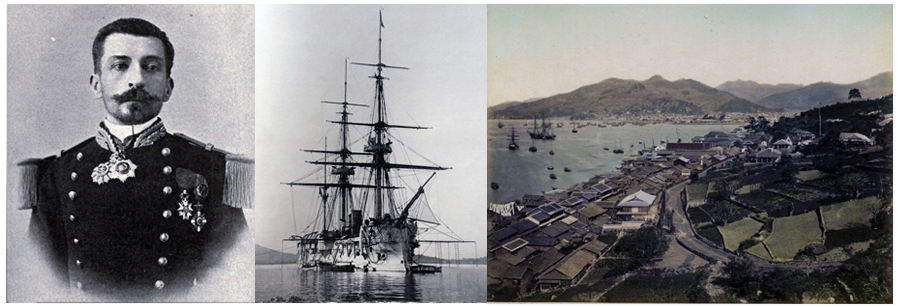 |
||
《Pierre Loti and Nagasaki》
Pierre Loti (1850-1923), the author of novel "Madame Chrysanthème," was born in
Rochefort, about 180km south of Bretagne. He entered the Navy Academy (École navale) in Brest when he was seventeen. He wrote a number of novels and travelogues of the places he traveled as a navy officer. These places include Turkey, Tahiti, India, China, Senegal and other places in the world. He also wrote novels based on his love experience with local ladies. Loti was a member of honorable Académie Française and became a famous writer in France as he was honored in the national funeral upon his death in 1923.
The novel "Madame Chrysanthème" described that Loti was guided by a rickshaw driver to a restaurant, Hyakkaen, right after arriving at Nagasaki. In our visit, we could not find Hyakkaen restaurant. Instead, we found a historic restaurant, Kagetsu, still operating nearby Loti’s dwelling. Kagetsu, used to be called Hikitaya, was a salon for international people (in negative terms, it was a brothel.). Hikitaya had profound history, being established in 1642. It was in the center of Maruyama, one of the three biggest geisha quarters in Japan along with Yoshiwara in Yedo (today’ Tokyo) and Shimabara in Kyoto. Those who used to go to Maruyama include the names appeared in the history book like Ryoma Sakamoto, Kaishu Katsu, Shinsaku Takasugi, Takayoshi Kido, Yataro Iwasaki, and Sanyo Rai. Tsuru-san, who became wife of Thomas Glover and Okane-san, the model of the novel "Madame Chrysanthème" were also geisha from Maruyama. Restaurant Kagetsu today serves the Shippoku dish, an original dish from Nagasaki. Shippoku is a course meal with one large plate. On the plate Japanese, Chinese, and Western meals are served together. It is also called Japanese-Chinese-Dutch cuisine as it has a strong influence from Holland (Holland had a trading house in Dejima, Nagasaki). In the Japanese translation of the novel, the restaurant is named Hyakkaen (Garden of Hundred Flowers). In the original French, Loti wrote “Jardin-des-Fleurs (Flower Garden)”. Translator, Toyoichiro Nogami, added “Hundred” to make it Hyakkaen. Indeed, no one from overseas would recognize Hikitaya and Flower Garden is not so elegant.
The novel "Madame Chrysanthème" described that Loti was guided by a rickshaw driver to a restaurant, Hyakkaen, right after arriving at Nagasaki. In our visit, we could not find Hyakkaen restaurant. Instead, we found a historic restaurant, Kagetsu, still operating nearby Loti’s dwelling. Kagetsu, used to be called Hikitaya, was a salon for international people (in negative terms, it was a brothel.). Hikitaya had profound history, being established in 1642. It was in the center of Maruyama, one of the three biggest geisha quarters in Japan along with Yoshiwara in Yedo (today’ Tokyo) and Shimabara in Kyoto. Those who used to go to Maruyama include the names appeared in the history book like Ryoma Sakamoto, Kaishu Katsu, Shinsaku Takasugi, Takayoshi Kido, Yataro Iwasaki, and Sanyo Rai. Tsuru-san, who became wife of Thomas Glover and Okane-san, the model of the novel "Madame Chrysanthème" were also geisha from Maruyama. Restaurant Kagetsu today serves the Shippoku dish, an original dish from Nagasaki. Shippoku is a course meal with one large plate. On the plate Japanese, Chinese, and Western meals are served together. It is also called Japanese-Chinese-Dutch cuisine as it has a strong influence from Holland (Holland had a trading house in Dejima, Nagasaki). In the Japanese translation of the novel, the restaurant is named Hyakkaen (Garden of Hundred Flowers). In the original French, Loti wrote “Jardin-des-Fleurs (Flower Garden)”. Translator, Toyoichiro Nogami, added “Hundred” to make it Hyakkaen. Indeed, no one from overseas would recognize Hikitaya and Flower Garden is not so elegant.
 |
||